- Home
- David R. George III
Crucible: Kirk Page 21
Crucible: Kirk Read online
Page 21
At the same time, I also had a vague notion in the back of my mind that I would like to somehow follow up my own favorite TOS episode, one of those often found at the tops of various fan polls regarding Trek’s finest hours. For a long time now, I’ve held aloft Harlan Ellison’s “The City on the Edge of Forever” as a high-water mark of the Original Series. So I asked myself if I could find some compelling means of employing the elements of that episode in the trilogy.
While allowing that idea to percolate, I took the time to view the entire series from beginning to end, from the first episode to the last, and then through the seven feature films. Although I had already seen each installment on many occasions over the years, this time I watched them from a different perspective, with an eye toward finding some facet of the characters that either hadn’t yet been explored or that would at least permit me to say something about them in a unique manner. As I saw and enjoyed one hour after another, I also realized that since the novels would be a part of the show’s anniversary celebration, I should attempt to deeply ground them in those original episodes. I did not wish to limit the tales to the five-year mission necessarily, but I thought that period should in some way play a significant role in the books. Of course, if I managed to tie in “The City on the Edge of Forever,” that likely would be the case anyway.
In watching the complete run of the series, I began to notice something about Dr. McCoy that I previously hadn’t. While I had at first imagined that fashioning a story to tell about the Enterprise’s chief medical officer would be more difficult than doing so for the ship’s captain and first officer, I suddenly saw that might not be true. McCoy, I realized, had lived as something of a loner, at least in terms of romance. Such a circumstance might not be considered that unusual during a long space voyage in the service of Starfleet, perhaps, but I also spied hints that this might be true of the good doctor even apart from his time aboard the Enterprise.
In “The Man Trap,” the very first Star Trek episode ever aired, back on Thursday, 8 September 1966, McCoy briefly mentions his involvement a decade earlier with a woman named Nancy, now married to Professor Robert Crater. In his captain’s log, Kirk refers to her as “that one woman in Doctor McCoy’s past.” McCoy himself seems alternately anxious and reluctant to see her, but little else is revealed about the erstwhile relationship, other than that they “walked out of each other’s lives ten years ago.”
Later in the first season, in the episode “Shore Leave,” McCoy appears to enjoy a dalliance with crew member Tonia Barrows, but the red-tressed yeoman never appears in the series after that, nor do any of the characters ever even speak of her again. McCoy then traverses the entire second season without even a hint of romance. In Star Trek’s third year, he finally finds love again, this time with Natira in the episode “For the World Is Hollow and I Have Touched the Sky.” But McCoy’s entanglement with the high priestess of Yonada seems as much a consequence of the unexpected discovery that he has xenopolycythemia and only a year left to live as of a real depth of romantic emotion.
And that’s it. Through the seventy-nine aired hours of Trek, and then through the seven films, those are the only instances in which McCoy’s love life is at all revealed. Still, throughout the three seasons and the movies, there is ample evidence that the doctor has an appreciation for the opposite sex. In “Mudd’s Women,” he is bewitched by Ruth; in “Wolf in the Fold,” he is anxious to visit a place that Kirk knows “where the women are so…”—so something left to the imagination; in “Is There in Truth No Beauty?” he appears enamored of Dr. Miranda Jones; and in The Wrath of Khan, he notes Saavik’s good looks. In even more episodes than that, McCoy demonstrates an obvious fondness for women.
Despite all of that, though, he is almost never seen to be involved with anybody. Even in “This Side of Paradise,” when he falls under the uplifting influence of the spores on Omicron Ceti III, he remains alone, sipping mint juleps by himself. Now, I’m sure that the numerous writers of the Original Series did not intend to convey anything in particular about McCoy by this dearth of romantic relationships, that my observations about the character are merely the result of an accidental artifact of episodic television in the 1960s. Still, all of that led me to a question for which I wanted to find an answer: Why did Dr. McCoy have so little love in his life?
At that juncture, I recalled a piece of non-canon information about the doctor long accepted by many Trek fans, namely that he had a failed marriage in his past, a difficult, broken relationship that ultimately had driven him out into space with Starfleet. This backstory originated, I knew, in early drafts of the episode that would ultimately become “The Way to Eden.” Instead of Chekov’s former girlfriend, Irina Galliulin, McCoy’s daughter Joanna came aboard the Enterprise. Further supporting the existence of Joanna, McCoy makes reference to his daughter in one of the twenty-two animated Star Trek adventures, “The Survivor.” It then occurred to me that an unsuccessful marriage spun McCoy’s character in a slightly different direction. Coupled with the loss of his relationships with Nancy, Tonia, and Natira, his failed attempt at matrimony made the question not why he’d had so few romances, but why they had never worked out for him.
I speculated that perhaps something in McCoy’s personality prevented him from remaining in long-term relationships. He might have developed a fear of intimacy or a fear of abandonment. There are reasons that such characteristics arise in a person, oftentimes tracing all the way back to their childhood. I already knew from the fifth Trek film, The Final Frontier, that McCoy had with great difficulty assisted in his father’s suicide when the elder McCoy lay dying and in pain. But what of McCoy’s mother? I wondered.
While I attempted to work out such details, I thought again about “The City on the Edge of Forever,” and suddenly I realized something. In that episode, when McCoy leaps through the Guardian of Forever and changes Earth’s history from the twentieth century onward, he causes the alteration to the timeline by preventing the death of Edith Keeler. Miss Keeler subsequently founds a peace movement that delays the United States’s entry into World War II, which in turn allows Nazi Germany and its allies to capture the world. As a result, the remainder of the Enterprise landing party find themselves totally alone on the Guardian’s planet, with no ship circling in orbit above them and, as Spock notes, “with no past, no future.” But in the modified past, I asked myself, what had become of McCoy?
All at once, I saw that an entire period of the doctor’s life had been hiding in plain sight. Yes, his time in Earth’s altered past had occurred in an alternate reality that ultimately gets reset, erased by Kirk and Spock chasing him back to 1930 and foiling him from stopping Keeler’s death, but still, it had happened. If I wanted to investigate that time, I knew that I would need to do two things in order to make the story work for readers. First, I would have to find some means of having the events of McCoy’s “other” life inform his “real” life, and second, I would need to utilize that other life to help explain and then deal with his pattern of unsuccessful relationships.
From there, the details of the story at last came together. I would produce parallel narratives, one taking place in McCoy’s “present,” during the Enterprise’s five-year mission and afterward, and one in his alternate past, beginning with his arrival in New York City in 1930. A title even suggested itself fairly quickly: Provenance of Shadows—making reference to the origin of the dark side of McCoy’s life that had prevented him from finding happiness with a romantic partner.
Once I had finished beating out the plots and themes for the McCoy novel, I turned my attention to Spock. I at once found a starting point for his story late in McCoy’s life, at a time when I knew that the two characters would come together in Provenance. I immediately liked that, seeing how I could tie the books together. From the two-part Next Generation episode “Unification,” I knew that Spock’s last canonical appearance had him on Romulus, where he sought to further the cause of reintegrating the Vulcan and Romula
n peoples, who had common forebears. I actually wrote a complete outline in relatively short order, putting together a highly complex political tale that employed elements of the first Crucible novel, the TNG episode in which Spock appeared, and the tenth Trek film, Nemesis. From a character point of view, it explored how and why reunification had become so important to Spock.
After sitting on the outline and mulling it over for a few days, though, I decided that I had made a mistake. Too much of the story took place in a time frame far beyond that of the TOS series and movies, and the study of Spock relied on his hopes for uniting the Vulcans and Romulans, an examination far less personal than would satisfy me. Consequently, I scrapped my ideas without ever even submitting the outline to my editor.
And so I began again, this time concentrating once more on the episodes of the Original Series and asking some of the same questions about Spock that I had posed to myself about McCoy. What didn’t I know about the character, and what would be worth discovering? I reviewed Spock’s arc, beginning with the earliest canonical experiences of his life—his birth, as depicted in The Final Frontier, and his near-death ordeal at the age of seven, as seen in the animated episode “Yesteryear”—through to his experiences as a Federation special envoy in the sixth film, The Undiscovered Country. To my satisfaction, I found something that didn’t quite scan for me, though I had never before thought about it. In Star Trek: The Motion Picture, it is revealed that, after the Enterprise’s five-year mission under Captain Kirk, Spock returned to Vulcan and sought to achieve the Kolinahr—the shedding of all emotion. I wanted to know why he had chosen to do that.
Now, I understood as well as any Trek fan that Spock has always considered himself Vulcan, not human, and that he subscribes to the lifestyle of the former and not the latter. He purports to control his emotions—a claim observably true in most cases—but it also seemed clear to me that he felt friendship for Kirk and McCoy, even if he rarely expressed himself in quite that way. Spock also appeared satisfied with his life. Why then had he elected to leave Starfleet, to leave his friends, and to endeavor to fully purge himself of emotion?
I thought about this for some time. The Motion Picture also revealed that Captain Kirk had been promoted after the end of the five-year mission to admiral, and posted to the position of chief of Starfleet Operations. Could that have motivated Spock to do what he’d done? That seemed unconvincing and not quite right to me. I couldn’t justify Spock’s resigning his commission and wanting to totally rid himself of emotion simply because his friend had moved on in his career.
Perhaps a traumatic event had befallen the first officer, I speculated. Because of their appearances in later films, I knew that both of his parents, Amanda and Sarek, were alive during the time frame in question, though The Next Generation would reveal their later demises. Surely Spock’s own death and then his rebirth in The Wrath of Khan and The Search for Spock, respectively, could be considered disturbing, but again, both had occurred after his decision to undergo the Kolinahr.
Since I could see nothing that would have reasonably impelled Spock to go back to Vulcan and try to completely eliminate his emotion, I wondered if I could develop that drive myself. But what form would that drive take? Once more, I looked to “The City on the Edge of Forever,” and again, that episode revealed something to me that I had never before realized.
When Kirk and Spock travel back in time through the Guardian of Forever in an attempt to avert the change McCoy made—or will make—to history, the first officer counsels his captain and friend that it is of paramount importance to restore—or maintain—the timeline. This appears quite clearly to be a core principle to Spock, one that he espoused quite plainly in an earlier first-season episode, “Tomorrow Is Yesterday.” It also seems reasonable: time and events have taken place, people have lived and died, and it would be unethical, perhaps even immoral, to alter those occurrences.
But then I considered the other occasions when Spock had traveled in time, and to my surprise, I saw that he had not always acted in concert with his professed convictions. In the animated episode “Yesteryear,” he intentionally alters the flow of history for the purpose of saving both his mother’s life and his own. And in The Voyage Home, he actually suggests plucking humpback whales from the past and bringing them into the future in order to attempt to save the population of Earth from an attacking alien probe. In both instances, though Spock possessed positive intentions which ultimately bore the fruits of his labors, he nevertheless violated the principle of striving to keep the timeline intact. He never appeared to consider doing so through the course of events in “The City on the Edge of Forever,” nor did he search for any means of sparing Captain Kirk the terrible loss of Edith Keeler. Perhaps he wouldn’t have been able to find a method of preserving the past without the death of Keeler, but he never even seemed to try.
This amounted to a subtle distinction in behavior, I knew, but one that I thought Spock and his acute, logical mind would discern. I also believed that Spock’s understanding of what he had done—acting in opposition to principle when it suited him, but having failed to do so when it would have most benefited his best friend—could prey on him, particularly when provoked to think about it during extreme circumstances. Such circumstances, I thought, might include Jim Kirk’s death.
It occurred to me then that, though Captain Kirk had passed away—at least as far as the people of the Federation knew—aboard the Enterprise-B, as seen in the film Generations, Spock’s reaction to that loss had never been seen. Faced with his friend’s death, perhaps the recollection of Spock’s failure to even try to save the love of Kirk’s life might resurface and push him to emotional distraction, perhaps even to the point where he would decide that he could no longer live with such intense feelings. And maybe a similar event had taken place at the end of the five-year mission as well, with Kirk believed dead and Spock having to face his guilt for having failed his friend in his time of need with Edith Keeler.
But if I chose to employ such a motivation for Spock at the end of the five-year mission, might that not also hold true when Kirk apparently died aboard the Enterprise-B? I saw then that I could explore Spock’s Kolinahr not by going backward to the time between the Original Series and The Motion Picture, but by sending Spock to Vulcan to attempt a purging of his emotions a second time. In so doing, I could then also explain his first such experience, while at the same time moving the character forward from the continuity of the films.
By choosing this course for my storytelling, I understood that I would have to address Spock’s emotional side, as well as his consistent decision to practice stoicism. I knew that the tale would be difficult to tell; investigating the feelings of a Vulcan, as well as the delicate nature of his guilt with Kirk, would not be easy. Still, I thought it a risk worth taking, in part because I recalled lines from the poem “Little Gidding,” by T. S. Eliot:
And all shall be well and
All manner of thing shall be well
When the tongues of flame are in-folded
Into the crowned knot of fire
And the fire and the rose are one.
In my mind, the fire represented Spock’s emotional life, his hidden, controlled passions, while the rose signified the perfect form of his logic. I also knew T. S. Eliot’s first lines in that stanza:
We shall not cease from exploration
And the end of all our exploring
Will be to arrive where we started
And know the place for the first time.
That seemed perfect to me. I could explore Spock’s internal battle between emotion and logic, attempt to deliver a richer, deeper understanding of the character, and yet not conclude with a Spock vastly different than the one everybody already knows, and who would later appear in The Next Generation. I knew that it would be a complex task, dealing with the feelings of a mostly impassive personality, an individual in whom intellect often won out over heart, but I thought it would be worth shining a light on
Spock in this way. So I decided to give it a shot.
Finally, then, I came to the tale of Captain Kirk. All along, I had believed that this would be the easiest of the three novels to develop. As with the other two stories, I would root the tale within the series and tie it into “The City on the Edge of Forever.” As dramatic as Kirk’s sacrifice of the woman of his dreams had been in that episode, there had never been any follow-up to it. Since “City” had taken place near the very end of the first season, and since Kirk’s brother and sister-in-law had also died in the very next installment, I thought that I could go back to the ensuing period, before the next year of episodes, and examine the captain’s reaction to such terrible losses in his life. What could be easier?
Except that I don’t really enjoy doing things that are easy. And I certainly do not like doing the expected. I reasoned that since the first two novels of the trilogy would be such heavy character pieces, perhaps I should consider a more action-oriented story for Kirk. I would still want to tie it in to the other two books through the crucible of the events in “The City on the Edge of Forever,” but I wanted to find an unpredictable means of doing so. I looked at Kirk’s life again, searching for the proper place to set my story, or at least to begin it.
Because of the impact his death would have on Spock in The Fire and the Rose, I found myself focusing on that incident. In Generations, Kirk acted nobly, agreeing to essentially eschew paradise and assist Picard in trying to stop Soran from causing the deaths of millions on Veridian IV. He and Picard succeeded, but Kirk perished in the attempt. A fitting end for the captain—selflessly saving lives—but I decided that I wanted him to save the universe just one more time.

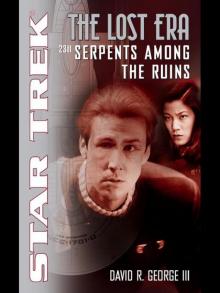 Serpents Among the Ruins
Serpents Among the Ruins The Fire and the Rose
The Fire and the Rose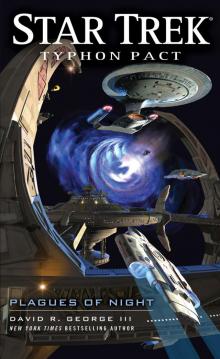 Star Trek: Typhon Pact 06: Plagues of Night
Star Trek: Typhon Pact 06: Plagues of Night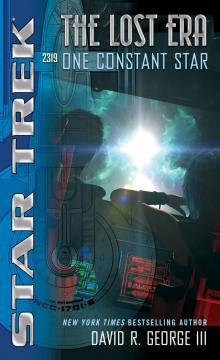 Star Trek: The Lost Era - 08 - 2319 - One Constant Star
Star Trek: The Lost Era - 08 - 2319 - One Constant Star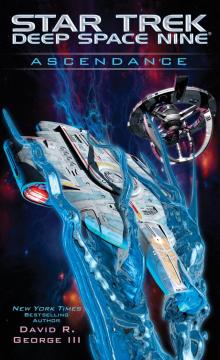 Star Trek: Deep Space Nine: Ascendance
Star Trek: Deep Space Nine: Ascendance Star Trek: TOS: Allegiance in Exile
Star Trek: TOS: Allegiance in Exile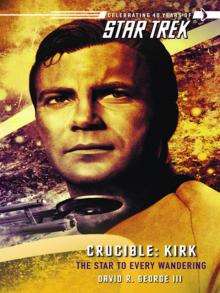 Crucible: Kirk
Crucible: Kirk Crucible: McCoy
Crucible: McCoy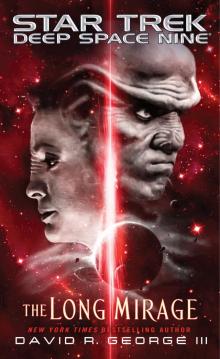 The Long Mirage
The Long Mirage Original Sin
Original Sin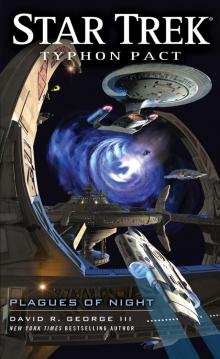 Star Trek: Typhon Pact: Plagues of Night
Star Trek: Typhon Pact: Plagues of Night Allegiance in Exile
Allegiance in Exile Sacraments of Fire
Sacraments of Fire Star Trek: Typhon Pact: Rough Beasts of Empire
Star Trek: Typhon Pact: Rough Beasts of Empire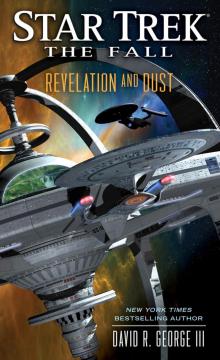 Star Trek: The Fall: Revelation and Dust
Star Trek: The Fall: Revelation and Dust